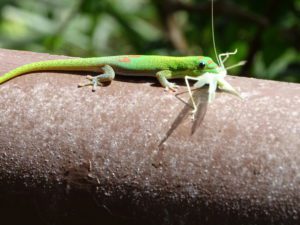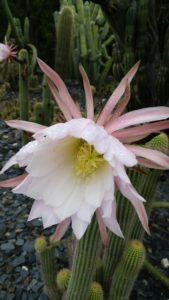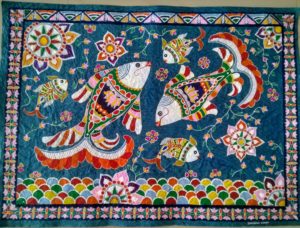“Sciences provide an understanding of a universal experience, art is a universal understanding of a personal experience. They are both avatars of human creativity.” – Mae Jemison
On December 7th, 2021, Schrödinger hosted its Inaugural Employee Art Exhibition at its new Headquarters in New York City. The organizers for this inaugural event called on Schrödinger Artists to contribute original artwork that expresses the essence of Biology, Chemistry/Materials, Computer Science and/or Physics. The NYC Headquarters has four floors and each floor is dedicated to one of these four areas of focus.
The exhibition recognized and congratulated the many talented Schrödinger artists from around the world that contributed their original art which has since been installed throughout the new HQ. Below are just a few of the art show submissions and a short description from the artist.


Spring Can’t Wait Iris
“Spring Can’t Wait” was painted during the peak of the pandemic (April/May 2021). New York was in a total shut-down back then, and a lot of us felt despair. However, that wouldn’t stop the flowers in our backyard from blooming. I used the magnolia flowers that are reaching to the sky in the painting to express how I yearned for getting out of the house and the return of a normal life.
“Iris” was painted from a little iris flower among a bouquet a friend of mine sent for my birthday. The painting was much larger than the real flower, which is a little unusual. I tried to capture how the sunlight illuminated the petals and the interplay of light and color. “A good painting is to make something ordinary look extraordinary.” This painting was my attempt at that.
– Yuling An, Product Manager, Machine Learning and Enterprise Informatics



Ducks in Lake Tahoe Hawaiian Lunch for the Gecko Cacti Santa Barbara
I had just graduated from UCDavis in California and was going to leave the U.S. as I had a job opportunity waiting in India. My mom flew from India to celebrate with a tour of San Francisco, Lake Tahoe and Hawaii. The picture of the duck was taken in Pope beach, South Lake Tahoe while we enjoyed a tranquil afternoon. I captured the gecko lunching on a grasshopper at Waimea valley in Haleiwa, Hawaii during a photography tour of the North Shore. Before returning home, my best friends and I took a road trip from Davis to Santa Barbara. Our visit to Lotusland was completely unplanned but a very pleasantly surprising one. That is where I captured the cactus flower in full bloom and drenched in dew.
– Saheli Chatterjee, Associate QA Scientist II



Rainbow Peacock Madhuvani Pisces Krishna in Tokyo
I am always fascinated by Indian folk art; to name a few, Madhubani, Warli, Tanjore, Pattachitra, Pahari, Rajput, Kangra, etc. The themes are inspired by simple village life, festivals, glorifying the events/characters from ancient Hindu mythology, and painted colorful, simple yet minute details. The ‘Rainbow peacock’ and ‘Madhuvani Pisces’ are Madgivani art. ‘Krishna in Tokoyo’ artwork is inspired by Vietnamese eggshell painting.
– Shrabani Dinda, Senior Scientist I

Standing on the Shoulders of Giants
“If I have seen further it is by standing on the shoulders of giants.” – Issac Newton
To an outsider, programming is often seen as an individualistic endeavor, a task laboured in isolation. Fundamentally, computing is invisible, but the process of writing good software has always been a collective effort. This art was born out of that desire to concretely visualize how software is built on top of the foresight and labor of our predecessors.
Our collective git history, a version control software used to track and index changes in a set of files, was parsed to generate this visualization that spans from 1990, when the company was founded, to August, 2021. The horizontal x-axis spans the days of the year and the vertical axis marks plots ascending in year, while each individual subplot’s y-axis spans the number of commits, as in the number of times a developer made a change to the source code, which is universally reflected for everyone.
To add another layer of information, each day’s area under the curve is color coded to the programming language with the greatest number of new lines for that day. The change in colors reflects the rapid pace of change in the computing industry’s technical standards and hardware capabilities, as well as adaptation of newer technologies such as the web.
There are successes and failures recorded in this history, both equally valuable in guiding us to our present. It also raises a pertinent question: where are we going next?
– Monica Chelliah, Senior Developer II


The Sand Has Blood Vessels GWB as an Artery to Manhattan
A summertime walk on a beach in Maine made me realize how the beaches there are teaming with life – birds, crustaceans, beach mice, turtles, etc. As I walked on, the tide washed up and left this pattern on the sand (The Sand Has Blood Vessels), which took me back to anatomy class and pictures of the human circulatory system that I had studied. I began to wonder if the sand itself could be alive, to support all that beach life.
My son is the inspiration for GWB as an Artery to Manhattan. We went on a hike together in the Palisades Interstate Park, which is full of beautiful vistas. He was shooting all these wonderful pictures – he’s a much better photographer than me. I was just trying to keep up!
– Hamish Wright, VP, Translational Science



Puppies Wild Horses Flowers
I started learning how to draw/paint during the pandemic. While I was isolated at home, feeling disconnected from the outside world, drawing/painting became my own unique way to communicate with the world. I love looking through all kinds of beautiful pictures for ideas and inspiration and watching tutorial videos from youtube. It was fun, relaxing, and an incredibly rewarding experience. As a biologist, I always have a strong love of living things: animals, flowers, trees. When I draw/paint, I attempt to bring out the innocence, the pureness, and also the exuberant vitality.
– Wu Yin, Senior Director, DDAG
Moving forward, the Schrödinger Art Committee (SAC) will put out an annual call for submissions along with an organizing theme. The SAC will curate and mount the show in the NYC office. At the end of the year’s show, the framed artwork will be returned to the artist. We look forward to your submission next year!







